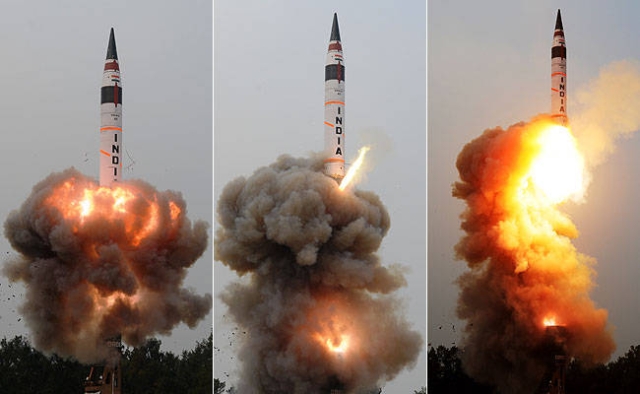India’s nuclear strategy To become intercontinental

International defence analysts have been equating India with Pakistan since ages, nowadays it akin to equating USA with North Korea.
Now an analysis of India’s nuclear forces published in the Bulletin of Atomic Scientists suggests that the focus of Indian nuclear strategy has been shifting from Pakistan to China. The Indian posture, according to the study has likely been reinforced after the 2017 Doklam standoff. These analysts should know that India is the second largest country in the world and so cannot be siloed into a regional compartment like South Asia or even Asia for that matter.
When India decided to go nuclear in 1974 and thereafter develop its own ballistic missiles
, there were numerous obstacles placed in its path by USA and other European countries. The final outcome of theirs was the Missile Technology Control Regime established in 1987.
Indian Scientists started working on various projects with a clear aim of carrying out incremental developments and then consolidating on it. So it is quite a wrong conclusion by authors of the above report Hans kristensen and Matt Korda stating “India’s nuclear strategy, which has traditionally focused on Pakistan, now appears to place increased emphasis on China and Beijing is now in the range of Indian missiles.”
Kristensen is the director of the Nuclear Information Project with the Federation of American Scientists in Washington, DC, while Korda is a research associate for the Nuclear Information Project at the Federation of American Scientists. The authors point out that India’s “nuclear modernisation indicates that it is putting increased emphasis on its future strategic relationship with China”.
The study predicts that India’s China focused approach is likely to contribute to development and deployment of new capabilities over the next 10 years and is also likely to impact India’s approach towards Pakistan.
The first of the Indian nuclear capable missile was the PRITHVI with a modest range of just 150 km and the next one AGNI1 had a range of 1500km. So naturally we talked about Pakistan only, though Abdul Kalam had already set his sights globally for a full fledged 16000 km ICBM.Once AGNI1 was perfected and deployed, our scientists moved on to Agni 2 and Agni 3. At the same time we started consolidating on PRITHVI and new variants PRITHVI2 and PRITHVI 3 were added. Once AGNI3 with around 3500 km was deployed, we were already looking at our main adversary China and work started on AGNI5 having a range of nearly 8000 km. This misdile can hit any part of China. Now the consolidating phase of developing MIVR, cannisterization, and improving accuracy, yield etc is going on, Next should be the SURYA 1 a 12000 Km range ICBM followed by the ultimate SURYA2.
Meanwhile after deploying the 1500 km
K15 Submarine launched ballistic missile, work was completed on K4 the 3500 km and the deployment phase is on. Work is now going on at fast pace on K5 which in all probability has a range of nearly 8000 km though officially it has been pegged at 5000km. After this should be the K7with 1200km range SLBM and finally the K8. In between there may be a K6 too providing the MIRV capabilities to the SLBMs.
India’s nuclear triad was officially accomplished following the announcement of completion of the first deterrence patrol of indigenous nuclear-powered ballistic missile submarine INS ARIHANT, by Indian Prime Minister Narendra Modi in November 2018.
The additional systems of India’s eight-legged nuclear triad are under development and will soon see completion. India currently operates at least two aircraft systems, four land-based ballistic missile system, and two sea-based ballistic missiles which are nuclear capable. More systems are in development, of which several are nearing completion and will soon be combat-ready. Beijing has long been in range of Indian ballistic missiles.
On the air front, India is likely to add the Rafale, which is used for the nuclear mission in the French Air Force, in addition to the Mirage 2000H and Jaguar IS aircraft. The Indian Mirage 2000H has been undergoing upgrades to extend its service life and enhance its capabilities, the modernised version is known as Mirage 2000I. The Indian Air Force is likely to phase out its Jaguar fleet over the next 15 years.
On land front, India has completed pre-induction flight test of the Agni-V near-intercontinental ballistic missile (ICBM) which is capable of delivering a warhead to nearly 8000km. With this additional range Agni-V launch bases may be located in central and southern India, further away from the Chinese border.
India is strengthening the sea-based leg of its nuclear triad. Soon there will be 3x Indian SSBNs submarine deployed in the IOR armed with K4 SLBMs Submarine launched ballistic missile (SLBM). Three more SSBN are under construction, this time much bigger in size to deploy K5 a 8000km SLBM, this would allow Indian submarines to target all of the Indo-Pacific region, including the South China Sea. In future these will get armed with K7 and K8.
Its time for India to start looking at a Space Force too.




